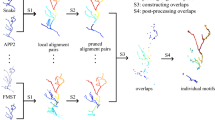Abstract
Neuron reconstruction is an important technique in computational neuroscience. There are many neuron reconstruction algorithms, but few can generate robust result, especially when a 3D microscopic image has low single-to-noise ratio. In this paper we propose a neuron reconstruction algorithm called fast marching spanning tree (FMST), which is based on minimum spanning tree method (MST) and can improve the performance of MST. The contributions of the proposed method are as follows. Firstly, the Euclidean distance weights of edges in MST is improved to be more reasonable. Secondly, the strategy of pruning nodes is updated. Thirdly, separate branches can be merged for broken neurons. FMST and several other reconstruction methods were implemented on the 120 confocal images of single neurons in the Drosophila brain downloaded from the flycircuit database. The performance of FMST is better than some existing methods for some neurons. So it is a potentially practicable neuron construction algorithm. But its performance on some neurons is not good enough and the proposed method still needs to be improved further.
Access this chapter
Tax calculation will be finalised at checkout
Purchases are for personal use only
Similar content being viewed by others
References
Xiao, H., Peng, H.: APP2: automatic tracing of 3D neuron morphology based on hierarchical pruning of a gray-weighted image distance-tree. Bioinformatics 29, 1448–1454 (2013)
Zhou, Z., Sorensen, S., Peng, H.: Neuron crawler: an automatic tracing algorithm for very large neuron images. In: Procedings of IEEE 2015 International Symposium on Biomedical Imaging: From Nano to Macro, pp. 870–874 (2015)
Chen, H., Xiao, H., Liu, T., Peng, H.: SmartTracing: self-learning-based neuron reconstruction. Brain Inform. 2, 135–144 (2015)
Peng, H., Long, F., Myers, G.: Automatic 3D neuron tracing using all-path pruning. Bioinformatics 27, i239–i247 (2011)
Yang, J., Gonzalez-Bellido, P.T., Peng, H.: A distance-field based automatic neuron tracing method. BMC Bioinform. 14, 93 (2013)
Wu, J., He, Y., Yang, Z., Guo, C., Luo, Q., Zhou, W., Chen, S., Li, A., Xiong, B., Jiang, T., Gong, H.: 3D BrainCV: simultaneous visualization and analysis of cells and capillaries in a whole mouse brain with one-micron voxel resolution. Neuroimage 87, 199–208 (2014)
Wang, Y., Narayanaswamy, A., Tsai, C.-L., Roysam, B.: A broadly applicable 3-D neuron tracing method based on open-curve snake. Neuroinformatics 9, 193–217 (2011)
Peng, H., Ruan, Z., Atasoy, D., Sternson, S.: Automatic reconstruction of 3D neuron structures using a graph-augmented deformable model. Bioinformatics. 26, i38–i46 (2010)
Ming, X., Li, A., Wu, J., Yan, C., Ding, W., Gong, H., Zeng, S., Liu, Q.: Rapid reconstruction of 3D neuronal morphology from light microscopy images with augmented rayburst sampling. PloS ONE 8, e84557 (2013)
Feng, L., Zhao, T., Kim, J.: NeuTube 10: a new design for efficient neuron reconstruction software based on the SWC format. eNeuro 2, 0049-0014 (2015)
Peng, H., Meijering, E., Ascoli, G.A.: From DIADEM to BigNeuron. Neuroinformatics 13, 259–260 (2015)
Peng, H., Hawrylycz, M., Roskams, J., Hill, S., Spruston, N., Meijering, E., Ascoli, G.A.: BigNeuron: large-scale 3D neuron reconstruction from optical microscopy images. Neuron 87, 252–256 (2015). doi:10.1016/j.neuron.2015.06.036
Peng, H., Ruan, Z., Long, F., Simpson, J.H., Myers, E.W.: V3D enables real-time 3D visualization and quantitative analysis of large-scale biological image data sets. Nat. Biotechnol. 28, 348–353 (2010)
Peng, H., Bria, A., Zhou, Z., Iannello, G., Long, F.: Extensible visualization and analysis for multidimensional images using Vaa3D. Nat. Protoc. 9, 193–208 (2014)
Shillcock, J., Hawrylycz, M., Hill, S., Peng, H.: Reconstructing the brain: from image stacks to neuron synthesis. Brain Inform. 1–5 (2016). doi:10.1007/s40708-016-0041-7
Sethian, J.: Level set methods and fast marching methods: evolving interfaces in computational geometry, fluid mechanics, computer vision, and materials science. In: Cambridge Monographs on Applied and Computational Mathematics, vol. 3, Cambridge University Press, Cambridge (1999)
Acknowledgments
This work is partially supported by the National Basic Research Program of China (No. 2014CB744600), National Natural Science Foundation of China (No. 61420106005), Beijing Natural Science Foundation (No. 4164080), and Beijing Outstanding Talent Training Foundation (No. 2014 000020124G039). The authors thank the BigNeuron project and Dr. Hanchuan Peng for providing the testing image data used in this article and many discussions.
Author information
Authors and Affiliations
Corresponding authors
Editor information
Editors and Affiliations
Rights and permissions
Copyright information
© 2016 Springer International Publishing AG
About this paper
Cite this paper
Hao, M., Yang, J., Liu, X., Wan, Z., Zhong, N. (2016). Fast Marching Spanning Tree: An Automatic Neuron Reconstruction Method. In: Ascoli, G., Hawrylycz, M., Ali, H., Khazanchi, D., Shi, Y. (eds) Brain Informatics and Health. BIH 2016. Lecture Notes in Computer Science(), vol 9919. Springer, Cham. https://doi.org/10.1007/978-3-319-47103-7_6
Download citation
DOI: https://doi.org/10.1007/978-3-319-47103-7_6
Published:
Publisher Name: Springer, Cham
Print ISBN: 978-3-319-47102-0
Online ISBN: 978-3-319-47103-7
eBook Packages: Computer ScienceComputer Science (R0)




